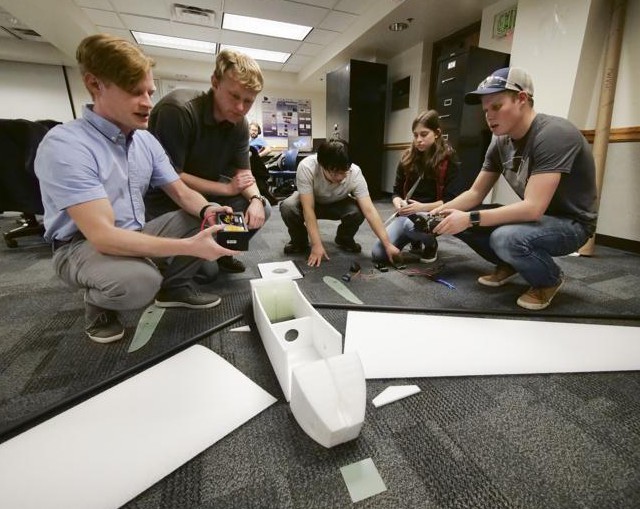Student researchers at the University of Colorado are planning to add the study of sperm whale communication patterns to the fast-growing list of tasks that can be aided by drone technology. And they — the students, not the whales — could use the public’s help.
CU’s 12-member Search and Help Aquatic Mammals UAS aerospace engineering student team — the acronym, appropriately, is SHAMU — is trying to raise funds for a project aimed at facilitating scientific research on sperm whale communication patterns.
Partnering with the Cetacean Echolocation Translation Initiative, SHAMU’s goal is to design, build and operate an unmanned aerial system, or drone, that would be used to find pods of whales in the open ocean.
“The most exciting thing to me is, it’s a real application of what I have been learning over the last four years,” said project manager Severyn Polakiewicz.
“And it’s applied to something that is beyond commercial or defense. It’s for the conservation of life on Earth. It improves our environment and improves humanity and also reveals the intelligence of massive mammals. And I think we should be understanding that intelligence on a better level because we do have the capability for it.”
The winged drone, with a wingspan of 3 meters and weighing 18 pounds, may have its inaugural launch this summer from a scientific research ship off the coast of Sri Lanka. It will be capable of spotting surfacing whales up to 7.45 miles from either side of the ship and then return to land on the vessel.
While in the air, the drone can send one photo back to the research ship per minute.
A smaller boat could then be dispatched in the right direction to get closer to the whales. Without such a spotting assist, researchers would be left to see what they might see with binoculars.
CETI’s co-founder is CU Professor Emeritus Jean Koster, of the Ann and H.J. Smead Aerospace Engineering Sciences Department, and she offered the capstone senior design project to CU students after first initiating the effort with support from the United Nations Sustainable Development Program.
The goal now is to broaden the study and record whale vocalizations, or clicks, used by sperm whales for echolocation, in an attempt to crack the code of sperm whale communication. It is hoped that deciphering their language might help conservationists defend whale populations against threats linked to noise pollution in the oceans.
The SHAMU team is under the supervision of its faculty adviser, Ann and H.J. Smead Aerospace Engineering Sciences Teaching Professor Donna Gerren, and in partnership with senior students at the U.S. Naval Academy in Annapolis, Md. The long-distance collaboration is geared to provide the students marketable experience in designing engineering systems in delocalized groups.
“I’m really proud of these students,” Gerren said. “I guess what’s really captured my imagination is that most of our senior projects involve designing a rover to explore different planetary surfaces, or making a test stand for a small-scale rocket.
“But this uses engineering to help a biological species from becoming extinct. It’s very applied. Not in the future but for tomorrow.”
Like many students, however, this crew needs money. The group landed some funding through the Ann and H.J. Smead Aerospace Engineering Sciences Department, but it could use more.
Phase one of the drone project, including outfitting the aircraft with launch and landing systems, is expected to cost $8,000. SHAMU also hopes for $2,000 to enable some CU students to join their Naval Academy partners for ship-based testing this summer.
Those inclined to pitch in can do so at the group’s colorado.edu/crowdfunding site. As of Friday, it showed just over $1,500 collected toward a goal of $10,000.
Polakiewicz hopes he might be one of the students who goes to sea with the drone. But he noted that students directly specializing in the piloting and communications aspects of the instrument will take precedence.
Also, Koster pointed out in an email that the drone may not actually make its debut on the research ship this summer.
“In case the aircraft is ready for missions we may be testing it,” Koster wrote. “As the whales are at certain times close to the shore we have the option to launch from the shore. The launch from, and landing on, a ship requires more development testing, technical verification and validation, and may not be feasible this summer without the high risk of losing the aircraft.”
Whether Polakiewicz is on hand this summer for its deployment or not, he believes the practical application for the science he has been studying, and partnering with the U.S. Naval Academy in service of a client, will prove invaluable.
“It’s a real environment,” he said. “It’s as close as you can get to industry, I think, without really being there.”
Koster added: “Many ocean biologists see the drone as a game changer for their research as they spend too much time and money on the oceans looking for whales to study them. The return on investment for the sponsor like the National Science Foundation could be increased significantly with our drone technology.”
Photo: From left, project manager Severyn Polakiewicz, aircraft design lead Grant Dunbar, electronics lead George Duong, Safety Lead Lauren McIntire and Test Lead Brandon Sundahl (Casey A. Cass / University of Colorado)
Source: Daily Camera


“Not in the future but for tomorrow.”
Um, hate to tell you but tomorrow is in the future.